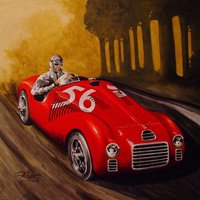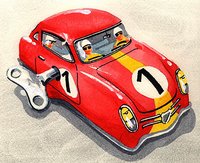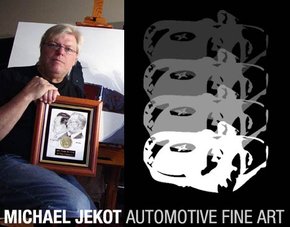Michael Jekot
Michael Jekot recalls encountering a sports car for the very first time in 1957. It was a rainy evening and the car was a dark colored Porsche Speedster. This began a respect for a classical design that established a solid foothold for the fabled marque in America.
Mike was born into an automotive family. His grandfather was a tool and die maker in Detroit, having emigrated from his native Poland before the War. He was employed by most of the major auto manufacturers during his working life and in his spare time enjoyed making toys in his basement workshop. Mike fondly remembers his grandparent's set of dining room chairs, which he eventually inherited, upholstered with material from the Graham-Paige upholstery shops.
While Mike's father chose medicine as a profession, he certainly had excellent taste in cars. During Mike's formative years he was exposed and given unfettered access to Corvettes, Porsches and Lamborghinis, among others.
Mike became serious about artwork in high school with encouragement from a teacher, who related to him that there was no such thing as a lazy artist. The influence of Salvador Dali’s surrealism steered Mike away from the sterility of photorealism as he developed his own focus on man's interaction with the automobile. He completed his formal education at the San Francisco Art Institute in 1970.
After school, his first employment was with area department stores in the specialty of visual merchandising. While maintaining this career, Mike made a brief foray into producing fine artwork after being commissioned by Bob Hagestad Porsche Audi in Denver, Colorado to create 20 commemorative watercolors depicting the history of Ferdinand Porsche and the company that bears his name. He even bought a 356 Porsche for further inspiration, but found an insufficient market for his work at that time and concentrated on his day job, eventually selling the car.

Fortunately, the calling returned in 1999 and Mike bought another inspirational Porsche 356. In March 2000 he put together an art show dubbed "Synthetic Oils" at a Minneapolis independent Porsche race shop. For this event, Mike created nine large canvases with a Porsche racing theme having a familiar man and machine emphasis. Also included were works of renowned automotive sculptors Lawrence Braun and Jeff Gamble. Despite a Minnesota scale blizzard that night, nearly 100 brave souls ventured out to experience the displays.
In addition to works from his own imagination, Mike also receives and produces commissions for creation of unique painted works. Paintings may be either acrylics on canvas or watercolors. A number of new works are always in development.
In 2001 Mike Jekot was selected to develop artwork for advertising and posters for the German AutoFest event hosted by Bob Campbell in Ventura, California. This arrangement has continued annually from that time to 2004. He was also invited to display his craft at this year's 50th Porsche Club of America Parade in Hershey, Pennsylvania taking a first place award in the professional class competition. He has also been published in Christophorus Magazine, Vintage Race Car Magazine and is a regular cover artist contributor to PML Magazine.

The style of his work is self-described as neo-representational. Subject matter represents a balance between man and machine, enhanced by creating contrasts between mechanical surfaces and personality, hard and soft, mind and matter. The subject vehicles are not always show cars or race winners, but convey a story that makes the observer wanting to know more. Mike compares his artwork respectfully to the automotive sculptures of Lawrence Braun as a mix of historic accuracy with a sense of motion and human interaction.
As his work has evolved Mike has found that the key to a successful project is based in research. He recalls a phone call from Brian Redman several years ago after a magazine had printed one of Mike's paintings featuring the 1970, 917 winner of Le Mans. He called to discuss a detail omitted in the piece. He was not angry, but expressed his desire for accuracy. "Remember, Mike," he said, "long after you're gone new people will be seeing this and taking it as the truth."
By both book and internet research and, if possible, active detailed questioning, the time spent learning to know both the subject and person translates to an understanding allowing for the creation of a more satisfying image. When developing a project featuring Erwin Komenda, Porsche's chief designer from the early days, Mike found himself speaking with Komenda's granddaughter. Getting her grandfather's story and many, many images of his early cars including the first 356 prototype roadster and coupes gave an interesting, unexpected insight. He decided that incorporation of the first 356 wood bucks, which were used to form the bodywork, was a much more important element than a finished car. After all, Komenda was instrumental in its design from the inside out, not just the skin, which covered all the rest.
When asked to indicate the most significant influence to his artistic endeavors, he cites his wife, Corinne for providing the honest eye of a true viewer and Carlos Santana for the best background music for painting.




